Effects of Quartz Precipitation on the Abundance and Preservation of Organic Matter Pores in Cambrian Marine Shale in South China
Abstract
1. Introduction
2. Geological Setting
3. Methods
4. Results
4.1. Bulk Rock Properties
4.2. Quartz Types and Silica Sources
4.2.1. Quartz Types
4.2.2. Silica Sources
4.3. Content of Biogenic Silica
5. Discussions
5.1. Corresponding Relation between Quartz Types and Silica Sources
5.2. Effects on the Abundance and Preservation of Organic Matter Pores
6. Conclusions
- In the estimated marine shale reservoir, quartz can be observed as four types, including detrital quartz, replacement of biosiliceous debris, euhedral quartz filled in the interparticle pores, and microquartz dispersed in a clay matrix.
- The dominant forms of authigenic quartz are euhedral quartz and microquartz. Euhedral quartz is much larger (1–5 μm) than microquartz (100–400 nm). Moreover, they have different positional relationships with porous organic matter. The porous organic matter fills the interior of the space composed of euhedral quartz, whereas microquartz is mostly surrounded by porous organic matter.
- The source of silica for the precipitation of authigenic quartz includes the dissolution of siliceous skeletons and the transition of smectite to illite. In the organic-rich shale samples, biogenic silica is most likely the major source for the authigenic quartz. The calculated excess Si (biogenic Si) ranges from 7 to 19 wt.% (average 11 wt.%), accounting for 23–57 wt.% (average 35 wt.%) of the total silica.
- The large-sized euhedral quartz present in the interparticle pores most likely results from the dissolution of siliceous skeletons at an early diagenesis stage. The silica for the clay matrix-dispersed microquartz is jointly provided by biogenic silica and clay-derived silica.
- The precipitation of early diagenetic euhedral quartz in the interparticle pores enhances rock stiffness, and the buttressing effect can protect the organic matter pores from compaction during the late-stage burial diagenesis. The precipitation of late diagenetic microquartz in the clay matrix can lead to a reduction in the retained petroleum, which would lead to a reduction in the amount of organic matter pores developed.
Author Contributions
Funding
Institutional Review Board Statement
Informed Consent Statement
Data Availability Statement
Conflicts of Interest
References
- Zou, C.; Yang, Z.; Dong, D.; Zhao, Q.; Chen, Z.; Feng, Y.; Li, J.; Wang, X. Formation, distribution and prospect of unconventional hydrocarbons in source rock strata in China. Earth Sci. 2022, 47, 1517–1533, (In Chinese with English abstract). [Google Scholar]
- Loucks, R.G.; Reed, R.M.; Ruppel, S.C.; Jarvie, D.M. Morphology, genesis, and distribution of nanometer-scale pores in siliceous mudstones of the Mississippian Barnett Shale. J. Sediment. Res. 2009, 79, 848–861. [Google Scholar] [CrossRef]
- Katz, B.J.; Arango, I. Organic porosity: A geochemist’s view of the current state of understanding. Org. Geochem. 2018, 123, 1–16. [Google Scholar] [CrossRef]
- Wasaki, A.; Akkutlu, I.Y. Permeability of organic-rich shale. SPE J. 2015, 20, 1384–1396. [Google Scholar] [CrossRef]
- Guo, X.; Li, Y.; Borjigen, T.; Wang, Q.; Yuan, T.; Shen, B.; Ma, Z.; Wei, F. Hydrocarbon generation and storage mechanisms of deep-water shelf shales of Ordovician Wufeng Formation–Silurian Longmaxi Formation in Sichuan Basin, China. Pet. Explor. Dev. 2020, 47, 193–201, (In Chinese with English abstract). [Google Scholar] [CrossRef]
- Zou, C.; Dong, D.; Wang, S.; Li, J.; Li, X.; Wang, Y.; Li, D.; Cheng, K. Geological characteristics, formation mechanism and resource potential of shale gas in China. Pet. Explor. Dev. 2010, 37, 641–653, (In Chinese with English abstract). [Google Scholar] [CrossRef]
- Zhao, W.; Bian, C.; Li, Y.; Liu, W.; Dong, J.; Wang, K.; Zeng, X. Organic matter transformation ratio, hydrocarbon expulsion efficiency and shale oil enrichment type in Chang 73 shale of Upper Triassic Yanchang Formation in Ordos Basin, NW China. Pet. Explor. Dev. 2023, 50, 12–23, (In Chinese with English abstract). [Google Scholar] [CrossRef]
- Hill, R.J.; Zhang, E.; Katz, B.J.; Tang, Y. Modeling of gas generation from the Barnett shale, Fort Worth Basin, Texas. AAPG Bull. 2007, 91, 501–521. [Google Scholar] [CrossRef]
- Ko, L.T.; Loucks, R.G.; Zhang, T.; Ruppel, S.C.; Shao, D. Pore and pore network evolution of Upper Cretaceous Boquillas (Eagle Ford-equivalent) mudrocks: Results from gold tube pyrolysis experiments. AAPG Bull. 2016, 100, 1693–1722. [Google Scholar] [CrossRef]
- Borjigin, T.; Tao, C.; Hu, G.; Shen, B.; Ma, Z.; Pan, A.; Wang, J.; Wang, X.; Xu, E. Effect of hydrocarbon explusion efficiency on shale gas formation and enrichment. Pet. Geol. Exp. 2020, 42, 325–334+344, (In Chinese with English abstract). [Google Scholar]
- Jarvie, D.M.; Hill, R.J.; Ruble, T.E.; Pollastro, R.M. Unconventional shale-gas systems: The Mississippian Barnett Shale of north-central Texas as one model for thermogenic shale-gas assessment. AAPG Bull. 2007, 91, 475–499. [Google Scholar] [CrossRef]
- Ko, L.T.; Loucks, R.G.; Ruppel, S.C.; Zhang, T.; Peng, S. Origin and characterization of Eagle Ford pore networks in the South Texas Upper Cretaceous shelf. AAPG Bull. 2017, 101, 387–418. [Google Scholar] [CrossRef]
- Meng, M.; Peng, J.; Ge, H.; Ji, W.; Li, X.; Wang, Q. Rock fabric of lacustrine shale and its influence on residual oil distribution in the Upper Cretaceous Qingshankou Formation, Songliao Basin. Energy Fuels 2023, 37, 7151–7160. [Google Scholar] [CrossRef]
- Peng, J.; Milliken, K.L.; Fu, Q. Quartz types in the Upper Pennsylvanian organic-rich Cline Shale (Wolfcamp D), Midland Basin, Texas: Implications for silica diagenesis, porosity evolution and rock mechanical properties. Sedimentology 2020, 67, 2040–2064. [Google Scholar] [CrossRef]
- Milliken, K.L.; Olson, T. Silica diagenesis, porosity evolution, and mechanical behavior in siliceous mudstones, Mowry Shale (Cretaceous), Rocky Mountains, USA. J. Sediment. Res. 2017, 87, 366–387. [Google Scholar] [CrossRef]
- Milliken, K. Compactional and mass-balance constraints inferred from the volume of quartz cementation in mudrocks. In Mudstone Diagenesis; Research Perspectives for Shale Hydrocarbon Reservoirs, Seals, and Source Rocks; Camp, W.K., Milliken, K.L., Taylor, K., Fishman, N., Hackley, P.C., Macquaker, J.H.S., Eds.; American Association of Petroleum Geologists: Tulsa, OK, USA, 2019; Volume 120, pp. 33–48. [Google Scholar]
- Dong, T.; He, Q.; He, S.; Zhai, G.; Zhang, Y.; Wei, S.; Wei, C.; Hou, Y.; Guo, X. Quartz types, origins and organic matter-hosted pore systems in the lower cambrian Niutitang Formation, middle yangtze platform, China. Mar. Petrol. Geol. 2021, 123, 104739. [Google Scholar] [CrossRef]
- Milliken, K.L.; Ergene, S.M.; Ozkan, A. Quartz types, authigenic and detrital, in the Upper Cretaceous Eagle Ford Formation, South Texas, USA. Sediment. Geol. 2016, 339, 273–288. [Google Scholar] [CrossRef]
- Niu, X.; Yan, D.; Zhuang, X.; Liu, Z.; Li, B.; Wei, X.; Xu, H.; Li, D. Origin of quartz in the lower Cambrian Niutitang Formation in south Hubei Province, upper Yangtze platform. Mar. Petrol. Geol. 2018, 96, 271–287. [Google Scholar] [CrossRef]
- Xu, H.; Zhou, W.; Hu, Q.; Yi, T.; Ke, J.; Zhao, A.; Lei, Z.; Yu, Y. Quartz types, silica sources and their implications for porosity evolution and rock mechanics in the Paleozoic Longmaxi Formation shale, Sichuan Basin. Mar. Petrol. Geol. 2021, 128, 105036. [Google Scholar] [CrossRef]
- Liu, Z.; Xu, L.; Wen, Y.; Zhang, Y.; Luo, F.; Duan, K.; Chen, W.; Zhou, X.; Wen, J. Accumulation characteristics and comprehensive evaluation of shale gas in Cambrian Niutitang Formation, Hubei. Earth Sci. 2022, 47, 1586–1603, (In Chinese with English abstract). [Google Scholar]
- Chen, X.; Chen, L.; Jiang, S.; Liu, A.; Luo, S.; Li, H.; Li, P.; Chen, P. Evaluation of shale reservoir quality by geophysical logging for Shuijingtuo Formation of Lower Cambrian in Yichang area, central Yangtze. J. Earth Sci. 2021, 32, 766–777. [Google Scholar] [CrossRef]
- Wang, Y.; Zhai, G.; Liu, G.; Shi, W.; Lu, Y.; Li, J.; Zhang, Y. Geological characteristics of shale gas in different strata of marine facies in South China. J. Earth Sci. 2021, 32, 725–741. [Google Scholar] [CrossRef]
- Gao, J.; Li, Y.; He, S.; He, Z.; Li, S.; Wo, Y.; Li, W.; Zhai, G.; Zhao, J. Exploration discovery of shale gas and its indicative significance to mineralization of MVT Lead-Zinc deposit in Yichang area, West Hubei. Earth Sci. 2021, 46, 2230–2245, (In Chinese with English abstract). [Google Scholar]
- Zhai, G.; Wang, Y.; Bao, S.; Guo, T.; Zhou, Z.; Chen, X.; Wang, J. Major factors controlling the accumulation and high productivity of marine shale gas and prospect forecast in Southern China. Earth Sci. 2017, 42, 1057–1068, (In Chinese with English abstract). [Google Scholar]
- Liu, Y.; Zhai, G.; Xu, X.; Zhang, X.; Bai, L.; Yang, Y.; Cao, S. Logging identification of high quality shale of Niutitang Formation and Doushantuo Formation in western Hubei. Earth Sci. 2022, 47, 1791–1804, (In Chinese with English abstract). [Google Scholar]
- Wei, S.; He, S.; Hu, M.; Yang, W.; Guo, X.; Iglauer, S.; Zhai, G. Supercritical high-pressure methane adsorption on the Lower Cambrian Shuijingtuo shale in the Huangling anticline area, South China: Adsorption behavior, storage characteristics, and geological Implications. Energy Fuels 2021, 35, 19973–19985. [Google Scholar] [CrossRef]
- Wei, S.; He, S.; Pan, Z.; Zhai, G.; Yang, R.; Dong, T.; Yang, W. Characteristics and evolution of pyrobitumen-hosted pores of the overmature Lower Cambrian Shuijingtuo Shale in the south of Huangling anticline, Yichang area, China: Evidence from FE-SEM petrography. Mar. Petrol. Geol. 2020, 116, 104303. [Google Scholar] [CrossRef]
- Milliken, K.L. SEM-Based Cathodoluminescence Imaging for Discriminating Quartz Types in Mudrocks. In Proceedings of the SPE/AAPG/SEG Unconventional Resources Technology Conference, Denver, CO, USA, 12–14 August 2013. [Google Scholar]
- Xie, X.; Zhu, G.; Wang, Y. The influence of syngenetic hydrothermal silica fluid on organic matter preservation in lower Cambrian Niutitang Formation, South China. Mar. Petrol. Geol. 2021, 129, 105098. [Google Scholar] [CrossRef]
- Gao, P.; He, Z.; Lash, G.G.; Zhou, Q.; Xiao, X. Controls on silica enrichment of lower cambrian organic-rich shale deposits. Mar. Petrol. Geol. 2021, 130, 105126. [Google Scholar] [CrossRef]
- Worden, R.H.; Morad, S. (Eds.) Quartz Cementation in Oil Field Sandstones: A Review of the Key Controversies. In Quartz Cementation in Sandstones; Blackwell Science: Oxford, UK, 2000; pp. 1–20. [Google Scholar]
- Rutman, P.; Hoareau, G.; Kluska, J.-M.; Lejay, A.; Fialips, C.; Gelin, F.; Aubourg, C.; Bilbao, E.H. Diagenesis and alteration of subsurface volcanic ash beds of the Vaca Muerta Formation, Argentina. Mar. Petrol. Geol. 2021, 132, 105220. [Google Scholar] [CrossRef]
- Zhao, J.; Jin, Z.; Jin, Z.; Wen, X.; Geng, Y. Origin of authigenic quartz in organic-rich shales of the Wufeng and Longmaxi Formations in the Sichuan Basin, South China: Implications for pore evolution. J. Nat. Gas. Sci. Eng. 2017, 38, 21–38. [Google Scholar] [CrossRef]
- Iijima, A.; Tada, R. Silica diagenesis of Neogene diatomaceous and volcaniclastic sediments in northern Japan. Sedimentology 1981, 28, 185–200. [Google Scholar] [CrossRef]
- Halbach, M.; Halbach, P.; Lüders, V. Sulfide-impregnated and pure silica precipitates of hydrothermal origin from the Central Indian Ocean. Chem. Geol. 2002, 182, 357–375. [Google Scholar] [CrossRef]
- Adachi, M.; Yamamoto, K.; Sugisaki, R. Hydrothermal chert and associated siliceous rocks from the northern Pacific their geological significance as indication of ocean ridge activity. Sediment. Geol. 1986, 47, 125–148. [Google Scholar] [CrossRef]
- Yamamoto, K. Geochemical characteristics and depositional environments of cherts and associated rocks in the Franciscan and Shimanto Terranes. Sediment. Geol. 1987, 52, 65–108. [Google Scholar] [CrossRef]
- Boström, K.; Peterson, M.N.A. The origin of aluminum-poor ferromanganoan sediments in areas of high heat flow on the East Pacific Rise. Mar. Geol. 1969, 7, 427–447. [Google Scholar] [CrossRef]
- Hower, J.; Eslinger, E.V.; Hower, M.E.; Perry, E.A. Mechanism of burial metamorphism of argillaceous sediment: 1. Mineralogical and chemical evidence. GSA Bull. 1976, 87, 725–737. [Google Scholar] [CrossRef]
- Peltonen, C.; Marcussen, Ø.; Bjørlykke, K.; Jahren, J. Clay mineral diagenesis and quartz cementation in mudstones: The effects of smectite to illite reaction on rock properties. Mar. Petrol. Geol. 2009, 26, 887–898. [Google Scholar] [CrossRef]
- Bjørlykke, K.; Egeberg, P.K. Quartz cementation in sedimentary basins. AAPG Bull. 1993, 77, 1538–1548. [Google Scholar]
- Isaacs, C.M. Influence of rock composition on kinetics of silica phase changes in the Monterey Formation, Santa Barbara area, California. Geology 1982, 10, 304–308. [Google Scholar] [CrossRef]
- Blood, R.; Lash, G.; Bridges, L. Biogenic silica in the Devonian shale succession of the Appalachian Basin, USA. In Proceedings of the AAPG 2013 Annual Convention and Exhibition, Pittsburgh, PA, USA, 19–22 May 2013; Volume 50864, pp. 19–22. [Google Scholar]
- Wright, A.M.; Spain, D.; Ratcliffe, T.K. Application of inorganic whole rock geochemistry to shale resource plays. In Proceedings of the Canadian Unconventional Resources and International Petroleum Conference, Calgary, AB, Canada, 19–21 October 2010. [Google Scholar]
- Dong, T.; Harris, N.B.; Ayranci, K.; Yang, S. The impact of rock composition on geomechanical properties of a shale formation: Middle and Upper Devonian Horn River Group shale, Northeast British Columbia, Canada. AAPG Bull. 2017, 101, 177–204. [Google Scholar] [CrossRef]
- Dowey, P.J.; Taylor, K.G. Extensive authigenic quartz overgrowths in the gas-bearing Haynesville-Bossier Shale, USA. Sediment. Geol. 2017, 356, 15–25. [Google Scholar] [CrossRef]
- Sholkovitz, E.R.; Price, N.B. The major-element chemistry of suspended matter in the Amazon Estuary. Geochim. Cosmochim. Acta 1980, 44, 163–171. [Google Scholar] [CrossRef]
- Ross, D.J.K.; Bustin, R.M. Sediment geochemistry of the Lower Jurassic Gordondale Member, northeastern British Columbia. Bull. Can. Petrol. Geol. 2006, 54, 337–365. [Google Scholar] [CrossRef]
- Ross, D.J.K.; Bustin, R.M. Characterizing the shale gas resource potential of Devonian-Mississippian strata in the Western Canada sedimentary basin: Application of an integrated formation evaluation. AAPG Bull. 2008, 92, 87–125. [Google Scholar] [CrossRef]
- Dong, T.; He, S.; Chen, M.; Hou, Y.; Guo, X.; Wei, C.; Han, Y.; Yang, R. Quartz types and origins in the paleozoic Wufeng-Longmaxi Formations, Eastern Sichuan Basin, China: Implications for porosity preservation in shale reservoirs. Mar. Petrol. Geol. 2019, 106, 62–73. [Google Scholar] [CrossRef]
- Zhang, K.; Jiang, Z.; Yin, L.; Gao, Z.; Wang, P.; Song, Y.; Jia, C.; Liu, W.; Liu, T.; Xie, X.; et al. Controlling functions of hydrothermal activity to shale gas content-taking lower Cambrian in Xiuwu Basin as an example. Mar. Petrol. Geol. 2017, 85, 177–193. [Google Scholar] [CrossRef]
- Wedepohl, K.H. Environmental influences on the chemical composition of shales and clays. Phys. Chem. Earth 1971, 8, 307–333. [Google Scholar] [CrossRef]
- Emmings, J.F.; Dowey, P.J.; Taylor, K.G.; Davies, S.J.; Vane, C.H.; Moss-Hayes, V.; Rushton, J.C. Origin and implications of early diagenetic quartz in the Mississippian Bowland Shale Formation, Craven Basin, UK. Mar. Petrol. Geol. 2020, 120, 104567. [Google Scholar] [CrossRef]
- Qiu, Z.; Liu, B.; Dong, D.Z.; Lu, B.; Yawar, Z.; Chen, Z.H.; Schieber, J. Silica diagenesis in the Lower Paleozoic Wufeng and Longmaxi Formations in the Sichuan Basin, South China: Implications for reservoir properties and paleoproductivity. Mar. Petrol. Geol. 2020, 121, 104594. [Google Scholar] [CrossRef]
- Van der Weijden, C.H. Pitfalls of normalization of marine geochemical data using a common divisor. Mar. Geol. 2002, 184, 167–187. [Google Scholar] [CrossRef]
- Tribovillard, N.; Algeo, T.J.; Lyons, T.; Riboulleau, A. Trace metals as paleoredox and paleoproductivity proxies: An update. Chem. Geol. 2006, 232, 12–32. [Google Scholar] [CrossRef]
- Perry, E.; Hower, J. Burial diagenesis in Gulf Coast Pelitic sediments. Clays Clay Miner. 1970, 18, 165–177. [Google Scholar] [CrossRef]
- Hoffman, J.; Hower, J. Clay mineral assemblages as low grade metamorphic geothermometers: Application to the thrust faulted disturbed belt of Montana, USA. In Aspects of Diagenesis; Scholle, P.A., Schluger, P.R., Eds.; SEPM Society for Sedimentary Geology: Tulsa, OK, USA, 1997; pp. 55–79. [Google Scholar]
- Bjørlykke, K. Clay mineral diagenesis in sedimentary basins—A key to the prediction of rock properties. Examples from the North Sea Basin. Clay Miner. 1998, 33, 15–34. [Google Scholar] [CrossRef]
- Mondol, N.H.; Bjørlykke, K.; Jahren, J.; Høeg, K. Experimental mechanical compaction of clay mineral aggregates—Changes in physical properties of mudstones during burial. Mar. Petrol. Geol. 2007, 24, 289–311. [Google Scholar] [CrossRef]
- Thyberg, B.; Jahren, J. Quartz cementation in mudstones: Sheet-like quartz cement from clay mineral reactions during burial. Pet. Geosci. 2011, 17, 53–63. [Google Scholar] [CrossRef]
- Metwally, Y.M.; Chesnokov, E.M. Clay mineral transformation as a major source for authigenic quartz in hermos-mature gas shale. Appl. Clay Sci. 2012, 55, 138–150. [Google Scholar] [CrossRef]
- Van de Kamp, P.C. Smectite-illite-muscovite transformations, quartz dissolution, and silica release in shales. Clays Clay Miner. 2008, 56, 66–81. [Google Scholar] [CrossRef]
- Środoń, J.; Zeelmaekers, E.; Derkowski, A. The charge of component layers of illite-smectite in bentonites and the nature of end-member illite. Clays Clay Miner. 2009, 57, 649–671. [Google Scholar] [CrossRef]
- Fu, H.; Yan, D.; Yao, C.; Su, X.; Wang, X.; Wang, H.; Li, Y. Pore structure and multi-scale fractal characteristics of adsorbed pores in marine shale: A case study of the Lower Silurian Longmaxi shale in the Sichuan Basin, China. J. Earth Sci. 2022, 33, 1278–1290. [Google Scholar] [CrossRef]
- Meng, M.; Ge, H.; Shen, Y.; Ji, W.; Li, Z. Insight into water occurrence and pore size distribution by nuclear magnetic resonance in marine shale reservoirs, southern China. Energy Fuels 2023, 37, 319–327. [Google Scholar] [CrossRef]
- Fishman, N.S.; Egenhoff, S.O.; Boehlke, A.R.; Lowers, H.A. Petrology and diagenetic history of the upper shale member of the late Devonian-early Mississippian Bakken Formation, Williston Basin, North Dakota. In Special Paper of the Geological Society of America; Geological Society of America: Boulder, CO, USA, 2015; Volume 515, pp. 125–151. [Google Scholar]
- Han, Y.; Horsfield, B.; Wirth, R.; Mahlstedt, N.; Bernard, S. Oil retention and porosity evolution in organic rich shales. AAPG Bull. 2017, 101, 807–827. [Google Scholar] [CrossRef]
- Bernard, S.; Wirth, R.; Schreiber, A.; Schulz, H.-M.; Horsfield, B. Formation of nanoporous pyrobitumen residues during maturation of the Barnett Shale (Fort Worth Basin). Int. J. Coal Geol. 2012, 103, 3–11. [Google Scholar] [CrossRef]
- Curtis, M.E.; Cardott, B.J.; Sondergeld, C.H.; Rai, C.S. Development of organic porosity in the Woodford Shale with increasing thermal maturity. Int. J. Coal Geol. 2012, 103, 26–31. [Google Scholar] [CrossRef]
- Yang, W.; He, S.; Zhai, G.; Tao, Z.; Yuan, X.; Wei, S. Maturity assessment of the Lower Cambrian and Sinian shales using multiple technical approaches. J. Earth Sci. 2021, 32, 1262–1277. [Google Scholar] [CrossRef]
- Mastalerz, M.; Drobniak, A.; Stankiewicz, A.B. Origin, properties, and implications of solid bitumen in source-rock reservoirs: A review. Int. J. Coal Geol. 2018, 195, 14–36. [Google Scholar] [CrossRef]
- Milliken, K.L.; Zhang, T.; Chen, J.; Ni, Y. Mineral diagenetic control of expulsion efficiency in organic-rich mudrocks, Bakken Formation (Devonian-Mississippian), Williston Basin, North Dakota, U.S.A. Mar. Petrol. Geol. 2021, 127, 104869. [Google Scholar] [CrossRef]
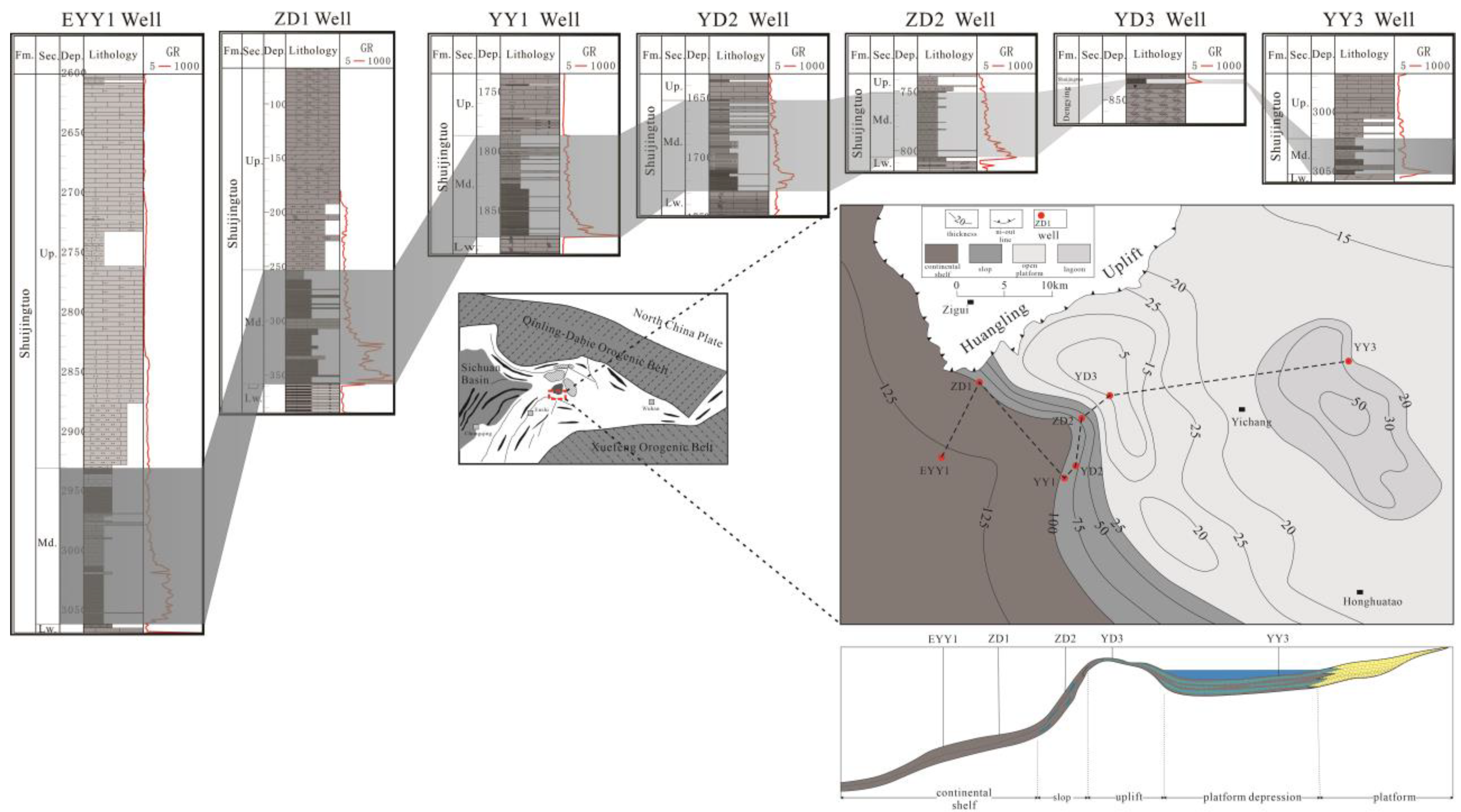
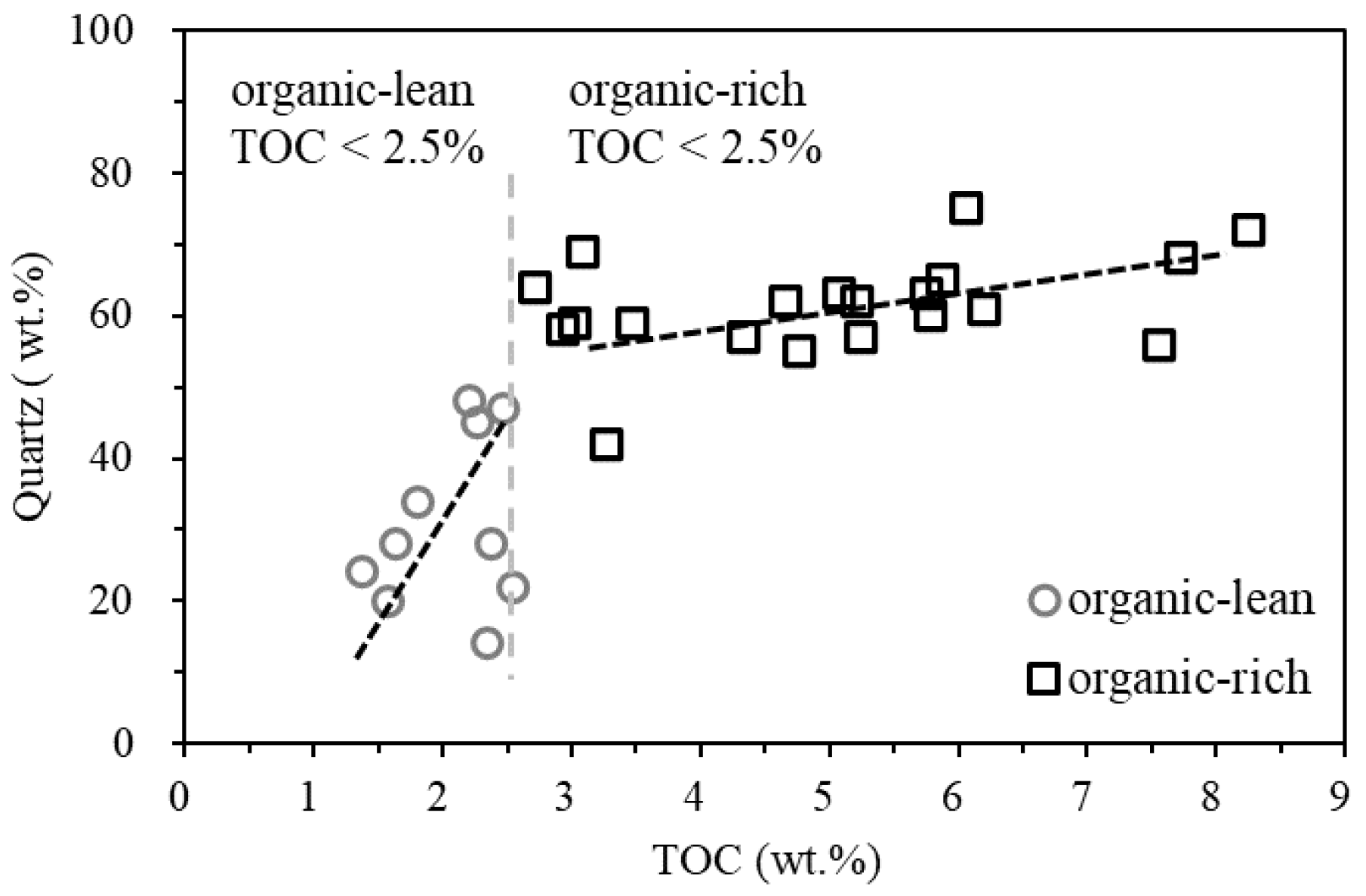
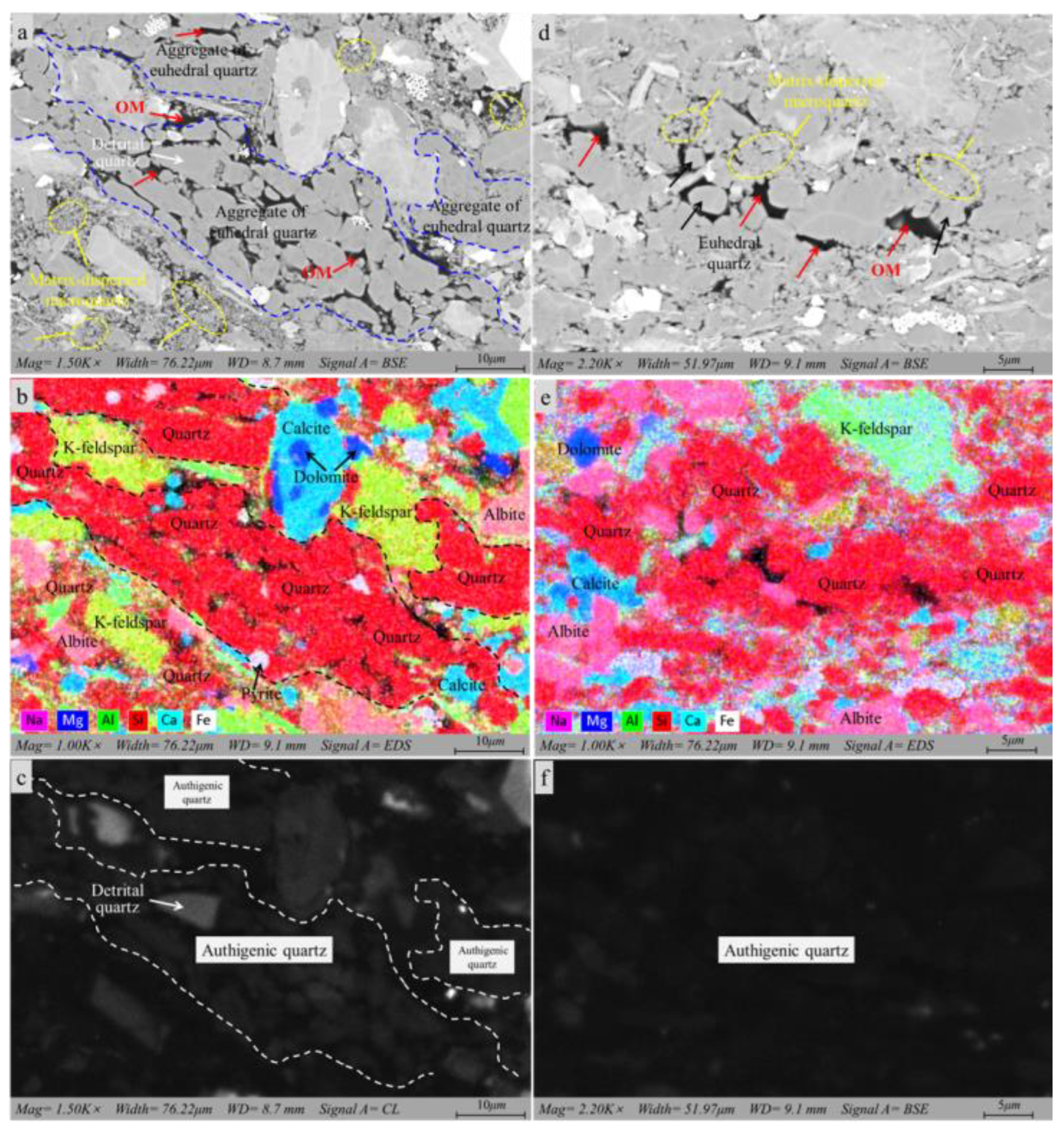

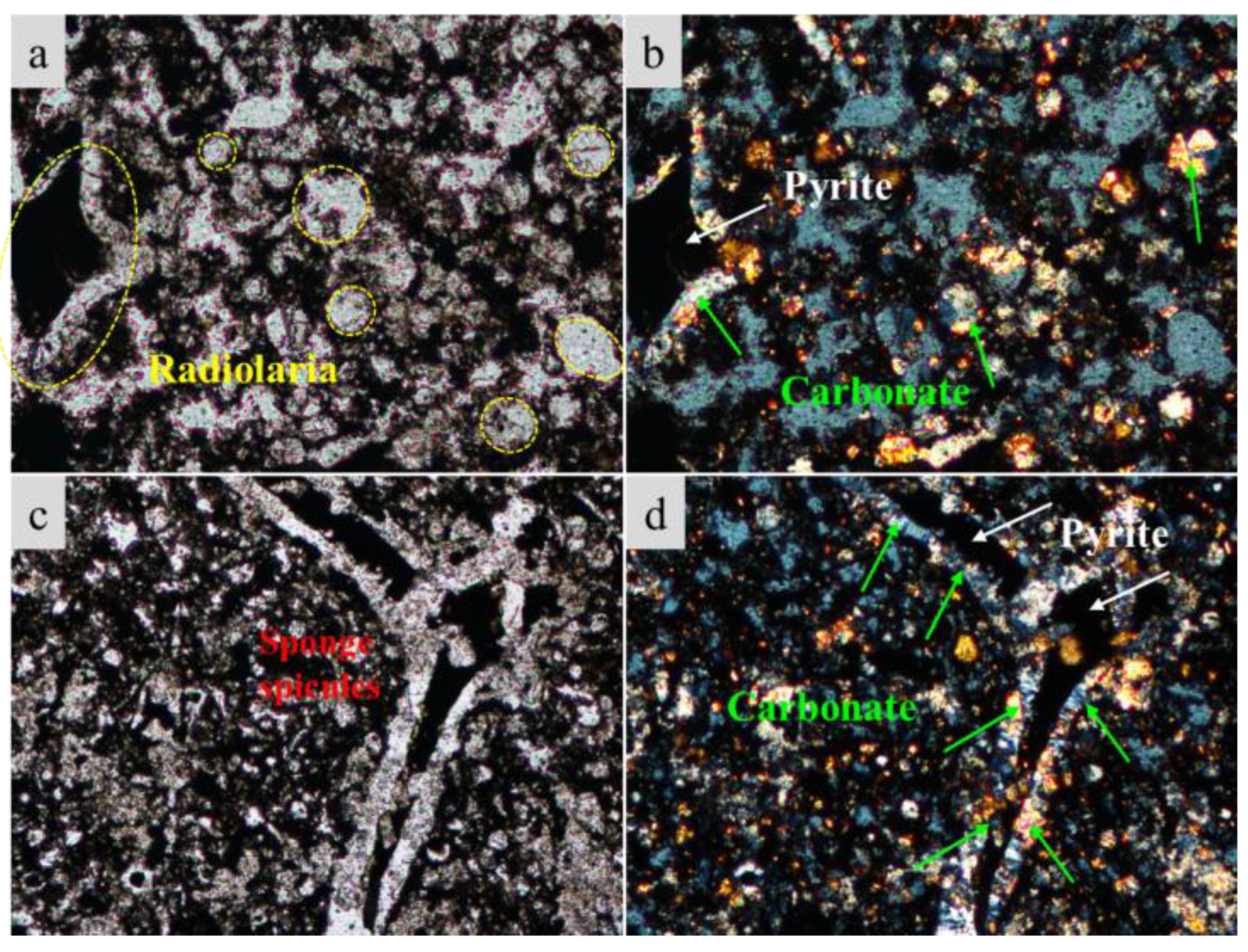
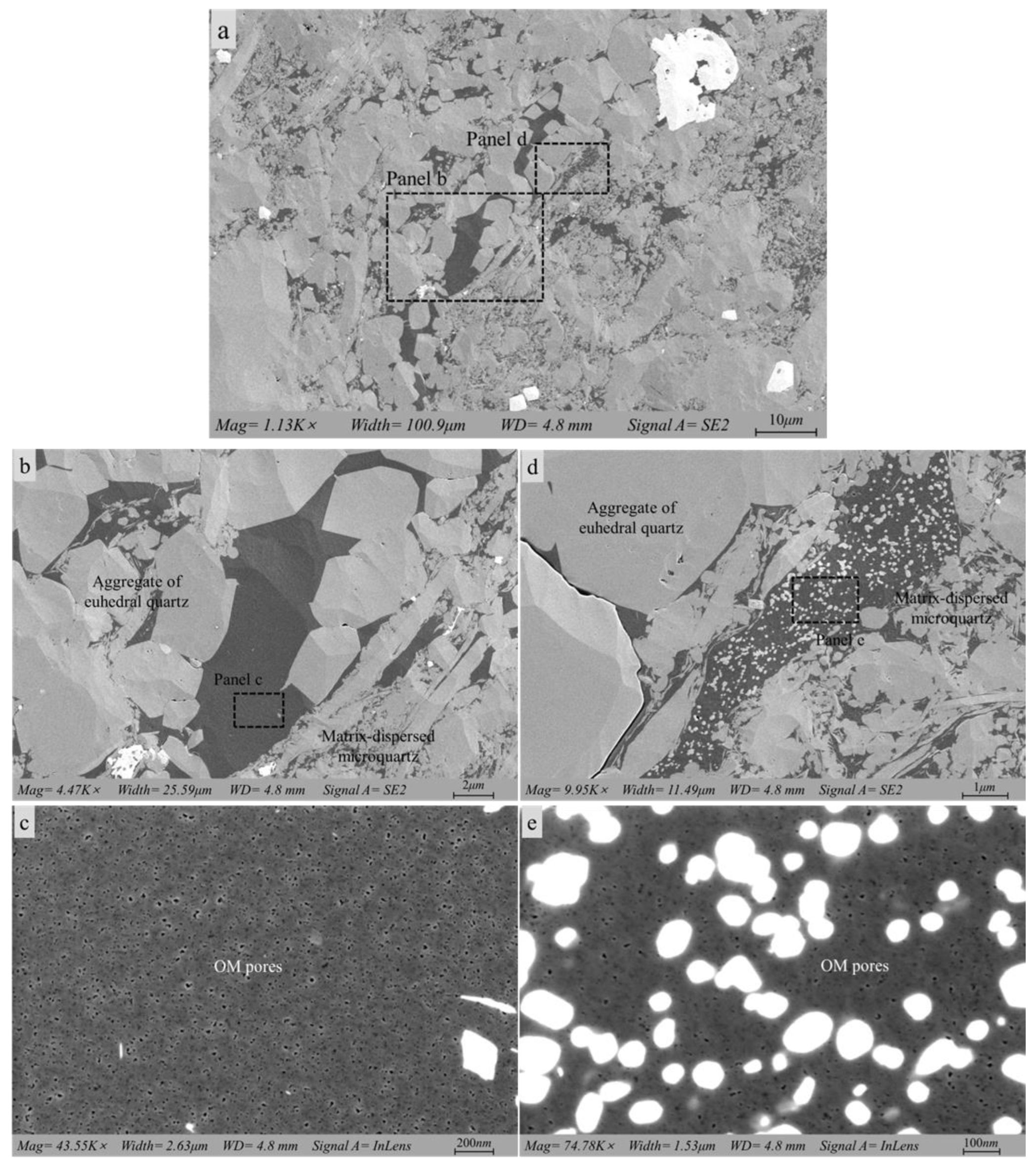



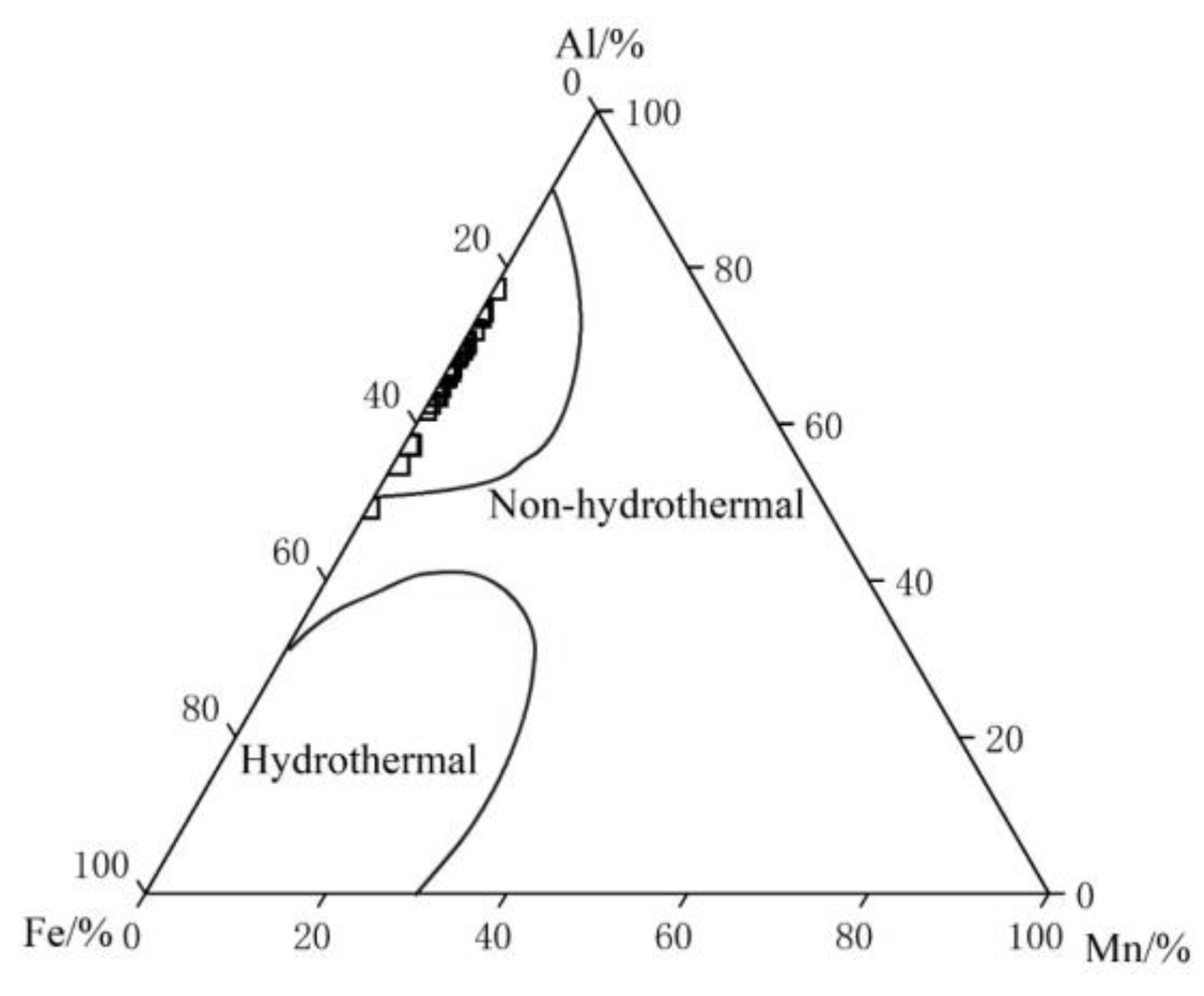
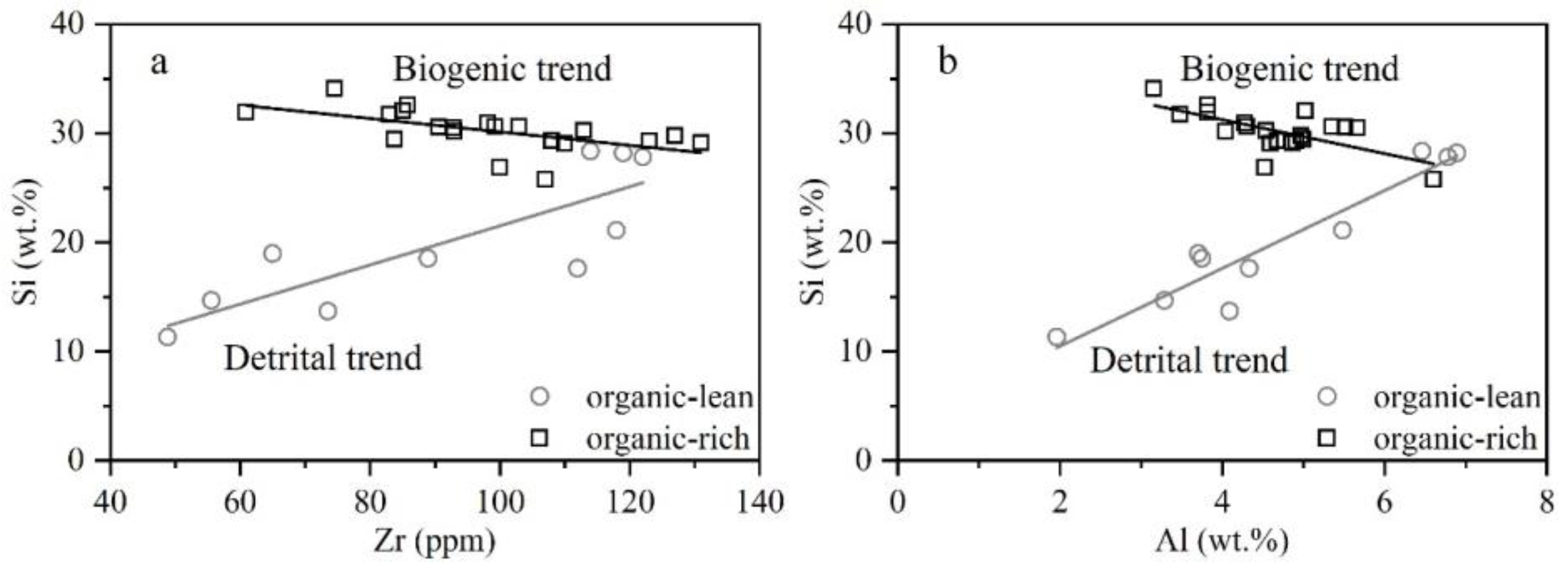
| Depth (m) | Organic | TOC (%) | Quartz (wt.%) | Carbonate (wt.%) | Clay (wt.%) | SiO2 (wt.%) | Al2O3 (wt.%) | Fe2O3 (wt.%) | MnO (wt.%) | Zr (ppm) | Al/(Al + Fe + Mn) |
|---|---|---|---|---|---|---|---|---|---|---|---|
| 2939.08 | -lean | 1.38 | 24 | 16 | 53 | 45.21 | 10.36 | 3.40 | 0.03 | 118 | 0.70 |
| 2975.53 | -lean | 1.63 | 28 | 33 | 30 | 31.47 | 6.21 | 3.45 | 0.06 | 55.6 | 0.57 |
| 2978.08 | -lean | 1.58 | 20 | 44 | 25 | 29.35 | 7.73 | 4.76 | 0.07 | 73.5 | 0.55 |
| 2983.63 | -lean | 2.47 | 47 | 8 | 30 | 59.62 | 12.81 | 3.32 | 0.02 | 122 | 0.74 |
| 2984.98 | -lean | 2.21 | 48 | 8 | 31 | 60.80 | 12.21 | 3.25 | 0.02 | 114 | 0.74 |
| 2989.32 | -lean | 1.80 | 34 | 31 | 26 | 40.68 | 7.00 | 3.90 | 0.05 | 65 | 0.57 |
| 2996.32 | -lean | 2.27 | 45 | 5 | 34 | 60.44 | 13.02 | 4.85 | 0.05 | 119 | 0.67 |
| 3003.50 | -rich | 2.72 | 64 | 5 | 20 | 68.67 | 9.49 | 2.10 | 0.02 | 85.1 | 0.77 |
| 3004.88 | -rich | 3.08 | 69 | 9 | 12 | 68.48 | 7.21 | 2.27 | 0.02 | 60.9 | 0.70 |
| 3007.34 | -rich | 2.93 | 58 | 5 | 24 | 65.38 | 10.71 | 3.91 | 0.02 | 92.9 | 0.67 |
| 3007.75 | -rich | 3.02 | 59 | 5 | 22 | 65.46 | 10.42 | 2.80 | 0.03 | 90.6 | 0.74 |
| 3008.78 | -rich | 3.47 | 59 | 8 | 21 | 63.06 | 9.45 | 2.75 | 0.03 | 83.8 | 0.72 |
| 3011.50 | -rich | 4.66 | 62 | 4 | 17 | 65.53 | 10.11 | 2.62 | 0.02 | 99.3 | 0.74 |
| 3020.54 | -rich | 4.33 | 57 | 8 | 17 | 62.42 | 9.20 | 3.77 | 0.02 | 131 | 0.65 |
| 3023.83 | -rich | 5.22 | 62 | 6 | 11 | 63.76 | 9.40 | 3.63 | 0.03 | 127 | 0.66 |
| 3024.33 | -rich | 5.24 | 57 | 7 | 20 | 62.71 | 9.27 | 3.55 | 0.02 | 123 | 0.66 |
| 3026.38 | -rich | 6.20 | 61 | 8 | 13 | 62.86 | 8.84 | 2.83 | 0.03 | 108 | 0.70 |
| 3030.18 | -rich | 5.78 | 60 | 8 | 12 | 62.26 | 8.68 | 3.25 | 0.03 | 110 | 0.67 |
| 3034.92 | -rich | 5.76 | 63 | 6 | 18 | 66.27 | 8.09 | 3.00 | 0.02 | 98.1 | 0.67 |
| 3037.53 | -rich | 4.76 | 55 | 13 | 16 | 57.55 | 8.54 | 3.67 | 0.03 | 100 | 0.64 |
| 3041.33 | -rich | 5.88 | 65 | 4 | 18 | 64.59 | 7.64 | 5.96 | 0.02 | 93.0 | 0.49 |
| 3043.48 | -rich | 5.08 | 63 | 4 | 20 | 69.82 | 7.22 | 2.44 | 0.01 | 85.8 | 0.69 |
| 3044.76 | -rich | 6.06 | 75 | 5 | 11 | 72.98 | 5.97 | 2.21 | 0.01 | 74.6 | 0.67 |
| 3053.03 | -lean | 2.54 | 22 | 61 | 11 | 24.29 | 3.70 | 1.58 | 0.02 | 48.8 | 0.64 |
| 3053.28 | -rich | 7.73 | 68 | 7 | 9 | 65.61 | 8.13 | 3.79 | 0.01 | 103 | 0.62 |
| 3053.88 | -rich | 8.25 | 72 | 5 | 10 | 68.04 | 6.58 | 2.96 | 0.01 | 83.0 | 0.63 |
| 3054.20 | -rich | 7.55 | 56 | 5 | 18 | 64.78 | 8.57 | 3.69 | 0.02 | 113 | 0.64 |
| 3062.70 | -lean | 2.34 | 14 | 60 | 16 | 37.73 | 8.18 | 2.77 | 0.02 | 112 | 0.69 |
| 3064.45 | -lean | 2.37 | 28 | 42 | 17 | 39.67 | 7.08 | 2.44 | 0.01 | 88.9 | 0.69 |
| Sample ID | Depth (m) | Organic | TOC (wt.%) | Quartz (XRD wt.%) | Biogenic Si (wt.%) | Biogenic Si /Total Si | Biogenic Quartz (wt.%) | Biogenic Quartz /Quartz (XRD) |
|---|---|---|---|---|---|---|---|---|
| EYY24 | 2939.08 | -lean | 1.38 | 24 | - | - | - | - |
| EYY42 | 2975.53 | -lean | 1.63 | 28 | - | - | - | - |
| EYY47 | 2978.08 | -lean | 1.58 | 20 | - | - | - | - |
| EYY61 | 2983.63 | -lean | 2.47 | 47 | - | - | - | - |
| EYY64 | 2984.98 | -lean | 2.21 | 48 | - | - | - | - |
| EYY74 | 2989.32 | -lean | 1.80 | 34 | - | - | - | - |
| EYY90 | 2996.32 | -lean | 2.27 | 45 | - | - | - | - |
| EYY103 | 3003.50 | -rich | 2.72 | 64 | 10.77 | 34% | 23 | 36% |
| EYY106 | 3004.88 | -rich | 3.08 | 69 | 14.98 | 47% | 32 | 47% |
| EYY111 | 3007.34 | -rich | 2.93 | 58 | 6.92 | 23% | 15 | 26% |
| EYY112 | 3007.75 | -rich | 3.02 | 59 | 7.51 | 25% | 16 | 27% |
| EYY114 | 3008.78 | -rich | 3.47 | 59 | 8.22 | 28% | 18 | 30% |
| EYY119 | 3011.50 | -rich | 4.66 | 62 | 8.12 | 27% | 17 | 28% |
| EYY138 | 3020.54 | -rich | 4.33 | 57 | 8.39 | 29% | 18 | 32% |
| EYY147 | 3023.83 | -rich | 5.22 | 62 | 8.65 | 29% | 19 | 30% |
| EYY148 | 3024.33 | -rich | 5.24 | 57 | 8.40 | 29% | 18 | 32% |
| EYY152 | 3026.38 | -rich | 6.20 | 61 | 9.28 | 32% | 20 | 33% |
| EYY159 | 3030.18 | -rich | 5.78 | 60 | 9.30 | 32% | 20 | 33% |
| EYY167 | 3034.92 | -rich | 5.76 | 63 | 12.29 | 40% | 26 | 42% |
| EYY172 | 3037.53 | -rich | 4.76 | 55 | 7.36 | 27% | 16 | 29% |
| EYY180 | 3041.33 | -rich | 5.88 | 65 | 12.35 | 41% | 26 | 41% |
| EYY187 | 3043.48 | -rich | 5.08 | 63 | 15.58 | 48% | 33 | 53% |
| EYY190 | 3044.76 | -rich | 6.06 | 75 | 19.41 | 57% | 42 | 55% |
| EYY204 | 3053.03 | -lean | 2.54 | 22 | - | - | - | - |
| EYY205 | 3053.28 | -rich | 7.73 | 68 | 11.91 | 39% | 26 | 38% |
| EYY206 | 3053.88 | -rich | 8.25 | 72 | 15.96 | 50% | 34 | 48% |
| EYY207 | 3054.20 | -rich | 7.55 | 56 | 10.70 | 35% | 23 | 41% |
| EYY223 | 3062.70 | -lean | 2.34 | 14 | - | - | ||
| EYY226 | 3064.45 | -lean | 2.37 | 28 | - | - |
| Depth (m) | Organic | TOC (wt.%) | Clay Mineral (vol.%) | Microquartz (vol.%) | Organic Matter (vol.%) | Other Mineral (vol.%) |
|---|---|---|---|---|---|---|
| 3053.03 | -lean | 2.54 | 41.08 | 27.5 | 18.69 | 12.73 |
| 3020.54 | -rich | 4.33 | 33.24 | 40.13 | 24.58 | 2.05 |
| 3041.33 | -rich | 5.88 | 16.67 | 52.20 | 31.13 | - |
| 3054.20 | -rich | 7.55 | 12.99 | 56.17 | 29.55 | 1.29 |
Disclaimer/Publisher’s Note: The statements, opinions and data contained in all publications are solely those of the individual author(s) and contributor(s) and not of MDPI and/or the editor(s). MDPI and/or the editor(s) disclaim responsibility for any injury to people or property resulting from any ideas, methods, instructions or products referred to in the content. |
© 2023 by the authors. Licensee MDPI, Basel, Switzerland. This article is an open access article distributed under the terms and conditions of the Creative Commons Attribution (CC BY) license (https://creativecommons.org/licenses/by/4.0/).
Share and Cite
Wei, S.; Hu, M.; He, S.; Shu, Y.; Dong, T.; He, Q.; Yang, W.; Cai, Q. Effects of Quartz Precipitation on the Abundance and Preservation of Organic Matter Pores in Cambrian Marine Shale in South China. J. Mar. Sci. Eng. 2023, 11, 1267. https://doi.org/10.3390/jmse11071267
Wei S, Hu M, He S, Shu Y, Dong T, He Q, Yang W, Cai Q. Effects of Quartz Precipitation on the Abundance and Preservation of Organic Matter Pores in Cambrian Marine Shale in South China. Journal of Marine Science and Engineering. 2023; 11(7):1267. https://doi.org/10.3390/jmse11071267
Chicago/Turabian StyleWei, Sile, Mingyi Hu, Sheng He, Yanbo Shu, Tian Dong, Qing He, Wei Yang, and Quansheng Cai. 2023. "Effects of Quartz Precipitation on the Abundance and Preservation of Organic Matter Pores in Cambrian Marine Shale in South China" Journal of Marine Science and Engineering 11, no. 7: 1267. https://doi.org/10.3390/jmse11071267
APA StyleWei, S., Hu, M., He, S., Shu, Y., Dong, T., He, Q., Yang, W., & Cai, Q. (2023). Effects of Quartz Precipitation on the Abundance and Preservation of Organic Matter Pores in Cambrian Marine Shale in South China. Journal of Marine Science and Engineering, 11(7), 1267. https://doi.org/10.3390/jmse11071267






